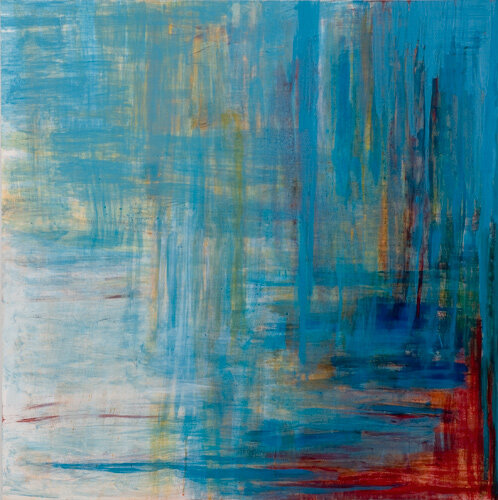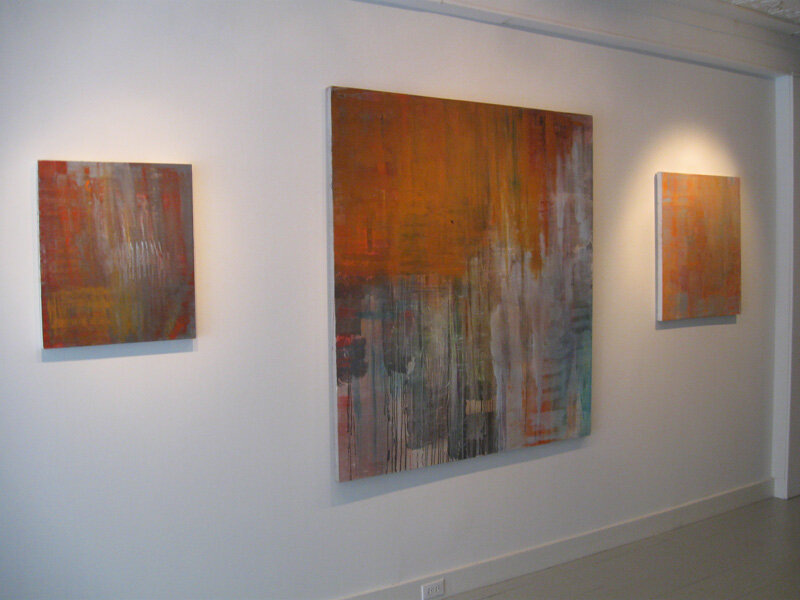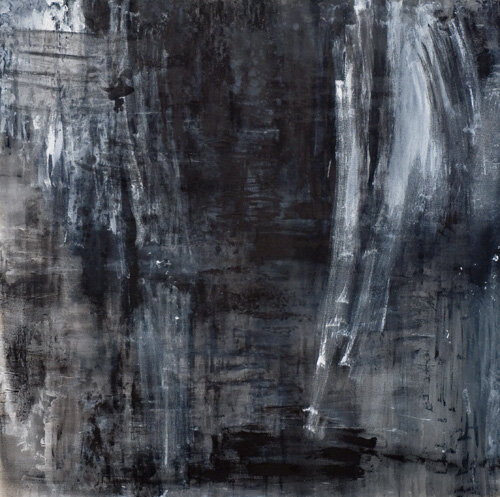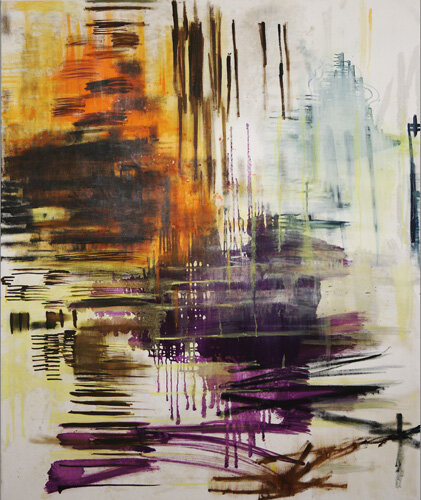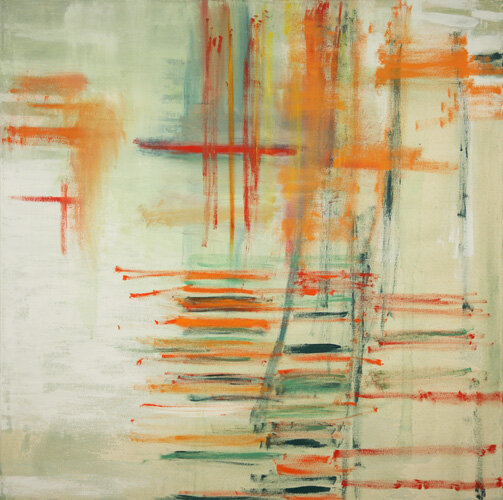Studio Art Tour Class Shines
by Mary McClellan, Bard Lifetime Learning Institute news, Fall 2024
Tom Fitzgibbon: Icebox4
by Etty Yaniv, Art Spiel, July 11th, 2024
Art Spiel, July 11th, 2024
X-rays, evil trees, divers dazzle at The Clemente
by Nancy Elsamanoudi, amNY, February 13, 2019
by Nancy Elsamanoudi, amNY, February 13, 2019
“Pole Jumper,” by Clintel Steed, oil on canvas, 16 in. x 20 in., 2018.
BY NANCY ELSAMANOUDI | If I could recommend one show to art lovers who might be a somewhat put off by New York City’s slightly insular gallery scene, or to anyone just looking for a great under-the-radar show, it would be the group show currently up at the Abrazo Interno Gallery at The Clemente.
This surprisingly magical, beautifully curated show has a celebratory vibe to it that seems to rebut, with a smirk, grumpy old muggle notions that painting is somehow dead. Indeed, some of the paintings literally seem to be grinning at us.
In Clintel Steed’s painting “3MM Dive,” a rock-hard male diver smiles as he plunges feet first into a sun-soaked scene at the local pool. It’s not quite clear if the central figure is an elite athlete, a scuba diver or an ordinary man dreaming of scuba diving. Either way, this painting is cinematic in its frenetic intensity.
“Lion,” by Mary Jones, oil, spray enamel, gold and silver leaf, feathered wallpaper on canvas mounted panel, 11 in. x 14 in., 2014.
In another painting, “Pole Jumper,” the image shifts depending on how far you stand away from it. From afar, you can make out a blur of a man in with his legs flung in the air. Up close, the image of the flying pole jumper is less readable. If you did not know quite what to look for, you would briefly think it was an abstract painting, until you begin to make out a head here and a leg there.
In JoAnne Carson’s painting “Knotty Pine,” a very different kind character takes center stage. In Carson’s piece, an anthropomorphic, evil-looking red tree with stumps for eyes and a massive, mischievous smile sits in the middle of a whacked-out, punchy landscape with orange clouds and pink foliage.
In another one of Carson’s paintings, “Dream Catcher,” the massive head of a bird peaks out of a very angular-looking and sharp tree set against a turquoise sky filled with cotton candy clouds. These paintings are like stills of Tim Burton’s films on hallucinogens or the three-eyed fish in “The Simpsons.”
“Overstitch,” by Kay Sirikul Pattachote, sewn on paper, 28.5 in. x 20.5 in, 2018.
These paintings’ perversely uncanny humor is suggestive of something menacing, such as the possibility the natural world may be mutating into something unnatural, or synthetic.
Kay Sirikul Pattachote’s paintings, “Overstitch” and “Overstitches #1,” of reddish violet roses in various states of bloom, also speak to the fragility of nature and the human condition but in a far more understated way. In these two works, the materiality of the work is profoundly important to its meaning. In this series, Pattachote combines several pieces of paper in a way that melds drawing, sewing, painting and collage. In parts of the paintings, the thread is clumped together to create a textured surface. In other areas, the thread is sewn in sinuous lines that follow the blossoms’ curves and the stem.
Mary Jones’s small-scale paintings also incorporate collage elements in an unexpected way. In Jones’s piece “Renaissance,” X-rays of a hip bone and spine are integrated with silver leaf, spray paint and oil paint into an overall composition that reads seamlessly as a painting with a cohesive paint surface rather than a collage with disparate elements awkwardly sticking out. “Lion” is another stunning work of hers.
Although Jones’s process may call to mind artists like Merlin James, her images involve a very different, specific and highly idiosyncratic vocabulary.
Over all, this is a phenomenal show filled with great paintings that are in conversation with each other. The show’s works were curated and beautifully installed by Kyle Heidenheimer and Camilla Fallon. The show also includes artwork by Mie Yim, Elisabeth Condon, Walter Schrank, Susanna Coffey, Laura Newman, Amy Manhick, Pinkney Herbert, Camilla Fallon and Kyle Heidenheimer.
“Incise, Echo and Repeat” is on view at Abrazo Interno Gallery at The Clemente (Clemente Soto Velez Cultural & Education Center), at 107 Suffolk St., between Rivington and Delancey Sts., until March 2. The gallery is open daily from 3:30 p.m. to 7 p.m., except for major holidays. For more information, visit theclementecenter.org .
Kylie Heidenheimer at Galerie Gris
by Amy Griffin, The Albany Times Union, July 3, 2013
by Amy Griffin, Albany Times Union, July 3, 2013
Hudson
Kylie Heidenheimer, whose solo show at Galerie Gris in Hudson opened in June and runs through July 15, is a painter's painter
Which is not to say that she makes paintings solely for other painters to the exclusion of the uninitiated. She is a painter who works in a specialized vernacular, but you don't have to speak the language to appreciate the message. In a show that includes 18 works — paintings on canvas or wood panel and some works on paper — she demonstrates her keen interest in finding dichotomies and the push and pull of space she creates on the canvas, showing evidence of the artist's hand versus withholding it.
Aggressive marks bump up against washes of color. Some brushstrokes almost hover on the surface creating a kind of curtain over layers of more color. Gallery owner Steve Isoz describes the effect she achieves as a kind of shimmer.
Indeed, in "Flame" (2011), bold horizontal and vertical marks in brown and purple recede, some begin to drip and others blur into colors below, giving the quality of a road on a hot day — that wavy quality caused by refraction that shimmers above the surface. The play between the build-up of paint, the washes, drips and strokes, give the painting a depth that sinks in as you look at it.
Heidenheimer, who splits her time between New York City and Hudson, says she's interested in "touching air," something that accounts for the ethereal quality of much of her work. Much of her process is about challenging herself to move out of her comfort zone. For "Flame," she chose purples and browns purposely because she gravitates toward blues. For a series of works on paper, she applied blobs of paint through screens to remove the physical mark-making she often utilizes. On one wall, three large canvases from 2009 show the artist experimenting with gray scale, as drips of black and smears of white suggest scenes obscured by rain on a window.
Isoz opened Galerie Gris on the north end of Warren Street just last year. With a background in advertising and marketing, his foray into running an art gallery grew out of a simple love of art.
An avid collector, he began showing work mostly by artists he'd collected.
Heidenheimer is the first artist he's shown whose work wasn't already familiar to him. It's a direction the gallery is continuing in as Isoz expands his roster.
He plans on mounting only solo exhibitions of artists he finds interesting and giving them six weeks, rather than the typical four. With a schedule common to Hudson galleries, the space is open Thursday through Monday, so the extra two weeks gives the work greater exposure.
Heidenheimer shows regularly in Brooklyn and Manhattan and has been featured in solo exhibitions at 532 Gallery Thomas Jaeckel and Columbia University, both in New York, and at Ohio Northern University.
The show at Galerie Gris is a sort of survey of her work, as Isoz chose a range of pieces, some from as far back as 15 years. The result is an engaging exhibit that exemplifies Heidenheimer's trajectory as an artist — a portrait, in a sense, of an artist not content to dwell in a single, comfortable mode of working.
Amy Griffin is a freelance writer in Delmar.
Shifting Ecologies at The Athens Cultural Center
Roll Magazine, 2015
Riva Weinstein - Hanging by Strings
SHIFTING ECOLOGIES II, as the title suggests, is the second exhibition on the same theme curated by Marianne Van Lent. The first Shifting Ecologies was shown at the Painting Center in the Chelsea district of Manhattan. The premise behind these exhibitions is to see how different artists explore ecological issues and changes to the environment in their work. Shifting Ecologies II features a diverse group of artists from the Hudson Valley and from New York City who embrace a sense of responsibility for defending the environment.
The word “ecology” was coined by Ernst Haeckel in 1878 and originates from the Greek word oikos meaning house or household. Haeckel, a naturalist, biologist, philosopher, physician, professor and artist, expanded the meaning to include habitats. From habitats the word has come to mean the study of the environment: addressing scientifically the interrelationships of living creatures and their conditions, including the biological and physical sciences.
Joan Ades — “Off the Grid”
In Shifting Ecologies II, Joan Ades addresses how technology has altered how we humans communicate with one another in a work wittily titled, Off the Grid. It is a collage as visually delicate as the now obsolete elements from which it is made. The work is pieced together from old maps, phone book listings, and musty fragments left in the 20th century’s wake that, as Ades wrote in her artist’s statement, “call to mind a time when the world was more than a maelstrom of zeroes and ones on a screen, when connections were palpable not virtual, and simplicity prevailed.”
Of her sculptural piece, Hanging by Strings (the image featured above the title), Riva Weinstein says, “it is a contemplation on the fragility of life and shifting eco-systems. Pine boughs are wrapped in mindful meditation.” Weinstein has for some time been making art and doing performances around the number 18 which is symbolic of life in the ancient mystical practice of Gematria. The performances have included invitations to people to join her in walking in circles at various locations around the state including, last winter, in Central Park in NYC. This piece continues with that theme: the wrapping of each bough is counted in increments of 18. More of Weinstein’s work can be seen, until August 8, at the Seligmann Center in Orange County.
One of the natural conditions of life is the alteration — sometimes subtle, often overt — of our environment. Industrial and technological expansions are triggering drastic environmental changes often resulting in mutations, diseases and pollution. The destruction of our earth from global warming, ozone depletion, acid rain, genetic engineering, toxic waste and the loss of our forests threaten not only our way of life, but our very survival. Claire Lambe remarked on the ways that pollutants create false positives, such as how fine particles of industrial dust, metals, and chemicals in the air make for “romantic tangerine dawns” and sulfuric acid aerosols create the most dramatic, and reddest, sunsets in her painting Hell from a Distance.
Claire Lambe, “Hell from a Distance”. Mixed media on canvas, 48”x 48”
William McDonough, a leader in promoting sustainability has said, “If everything that is received from the earth can be freely given back, without causing harm to any living system: this is ecology.” Eco artists may address the subject with on-site rigor and activism; painters address it with detached formalism and the language of painting. This show presents the way painters, in particular, are reacting to the current ecology of our planet and our ecological crisis and challenge.
Tasha Depp, “Fukushima Landscape”. Oil on linen, 22x31
Tasha Depp’s eerie men-on-the-moon-on-earth landscape needs no explanation other than to consider that hazmat suits may well be the garb for all of us in the not-so-distant future. Depp is also among the artists in this year’s Samuel Dorsky Museum’s Hudson Valley Artists exhibition at SUNY New Paltz.
The panel, on August 15, will present and discuss the interplay between art and science on the subject of environmental change and will conclude with a group manifestation by the river with multidisciplinary artist, activist, Carrie Dashow. In addition to those already mentioned, the artists in this exhibition include Nancy Azara , Sarah Barker, Kathy Bruce, Tina Chaden, Lisa Crafts, Ford Crull, Peggy Cyphers, Steve Derrickson, Priscilla Derven, Sarah Draney, Stuart Farmery, Deborah Freedman, Mark Gibian, Kylie Heidenheimer, Carter Hodgkin. Linda Horn, Elizabeth Knowles, Ellen Kozak, Barbara Laube, Ingrid Lisowski, Dana Matthews, Theresa Nicholas, Alastair Noble, Gina Occhiogrosso, Al Peters, Sara Pruiksma, Leah Rhodes, Sam Sebren, Phyllis Stoller, Jeff Vanderburg, Marjorie Van Dyke, Marianne Van Lent, and Gordana Vukovic.
Kylie Heidenheimer, “Woods”, acrylic, wax, pigment on canvas, 20”x20”
Curator Marianne Van Lent lives and works in NYC and Athens, NY on the Hudson River. She received her BFA from Tyler School of Art and her MFA from Cornell University. Van Lent’s paintings have been widely exhibited in the United States and Europe and inhabit many public and private collections. Recent exhibitions include “Cosmologies”, “Prima Materia” and “Nature Abstracted” at the Painting Center, New York, “Reflected Light”, a solo show at Ulla Surland Fine Art. Her works can be seen online here
This exhibition is made possible in part with public funds from the Decentralization Program of the NYS Council on the Arts, administered in Greene County by the Greene County Council on the Arts through the Community Arts Grants Fund. Additionional funding provided by the Athens Community Foundation.
All images are courtesy of the artists and the Athens Cultural Center.
Featured Image: Riva Weinstein, Hanging by Strings (detail), 2014. Dimensions variable
For more information visit the ACC website: here
Abstract Painting, Though Not Entirely
by Barry Schwabsky, The New York Times, October 25, 1998
by Barry Schwabsky, New York Times (New Jersey edition), October 25, 1998
IN its earlier styles, art was generally meant to represent nature. But modern art, abstraction in particular, has often professed to embody its operations. Thus, Jackson Pollock's celebrated affirmation: ''I am nature!''
Today, with technological developments, from digital imaging to cloning, rendering the sense of both reality and its representation less stable and more fluid, artists like those in ''Unnatural Selection: The Transformation of Nature in Abstraction,'' at the Art Gallery at Raritan Valley Community College here, seem to want to hedge their bets. Abstract painting is once again attractive because it can be a little of each, both a representation of reality and a sample of its processes.
The curator, Tom McGlynn, speaks in the exhibition catalogue of the ''uncanny ability of paint to embody natural phenomena in its apparently chance directions and at the same time to present a 'picture' of that embodiment.'' In practice, what this means is that all nine artists practice a self-consciously mannerist form of abstraction, enamored of incongruities and paradoxes, full of references to both the abstract (and not-so-abstract) painting of the recent past and the more diffuse visual cultures of the present -- not only artistic, but commercial, scientific, and so on. The kind of thinking manifest in their works is widespread in today's painting, and while the artists included in ''Unnatural Selection'' are not necessarily the best or the best-known representatives of that thinking, they are valid ones. Mr. McGlynn, an adjunct instructor in fine arts at the college, has not stumbled in avoiding the most obvious choices.
For some of these painters, it seems that color is the primary means for sparking the dialogue (or showdown) between artifice and nature. In Carolanna Parlato's confections of poured and pushed acrylic, the lyrical abstraction of painters of the 1960s and '70s, like Jules Olitski, seems to be turning toxic. As the artist herself notes in the catalogue, it is the way ''murky and Day-Glo colors coagulate'' in discordant abutting passages that creates the paintings' science-fiction feeling -- a feeling pervasive in this exhibition, in fact. The acidic froth of Ms. Parlato's paintings suggests the gaseous surface of an uninhabitable planet.
Elsewhere, it is shape that becomes more important, as in Gary Petersen's paintings in which flat, simple, nondescript forms sprout bumps that can be seen either as exaggerations of normal features, like breasts or noses, or as malignant ones, like cysts or tumors. Taking a cue from the grotesque imagery of Philip Guston's late work, these are essentially cartoons of abstraction, although whether their stolid yet animated shapes should be seen as silly or menacing is kept ambiguous.
This idea of growth as pathological moves from the pictorial content of the painting, as in Mr. Petersen's work, to its physical conformation in a dark, untitled 24-inch square from 1997 by a Los Angeles-based Englishman, Jeremy Kidd, in which globular protuberances disturb the painting's normal planarity.
Sign up for the New York Today Newsletter: Each morning, get the latest on New York businesses, arts, sports, dining, style and more.
A pedant might refer to Mr. Kidd's painting as a bas-relief, but a fully three-dimensional extension of painting is here in Madeleine Hatz's ''Desert Fluff'' (1998), a table-top agglomeration of pigments and various other materials, presented as a companion piece to her more conventionally pictorial ''Citrus Sfumato,'' also from 1998. The pieces are similar in palette, but where ''Citrus Sfumato'' is airy and light in feeling, ''Desert Fluff'' breaks that airiness down into something grainy, lunar, debrislike.
''What energizes a painting,'' Mr. McGlynn writes, ''is the painter's awareness of the constant struggle between the actual and the virtual.'' This play between reality and artifice has always been the artist's concern. Marianne Moore once called for poems that would be ''imaginary gardens with real toads in them.'' In Mr. Kidd's painting, possibly the strongest one here, I noticed a housefly frozen still on one of the lavish spills of clear resin that make up most of its immediate surface. Did the unlucky creature landed there while the stuff was still drying and been caught forever, like one of the cigarette butts Pollock is said to have tossed into his paintings now and then as he crouched over them, pouring paint and too caught up himself to stop? Or, given the general atmosphere of nature-as-illusion and artifice-as-natural, could the fly be a fake, like the ones in those trick ice cubes sold in novelty stores? After long minutes, when the seemingly immobilized fly insouciantly buzzed off and deflated these lucubrations, the line between art and reality only seemed blurrier.
''Unnatural Selection'' includes paintings by Bill Doherty, Kylie Heidenheimer, Giles Lyon, James Siena and Mr. McGlynn. Their work is generally a bit closer to familiar styles of abstract painting, whether based on geometry, on pattern or on gesture. Yet in each case there is some understated contradiction, a sense that painting, as Mr. Lyon puts it, ''is where . . . two paradigms meet.''
UNNATURAL SELECTION
The Art Gallery, Raritan Valley Community College, North Branch
Through Thursday. Hours: tomorrow, 3 to 8 P.M.; Tuesday, noon to 3 P.M.; Wednesday, 1 to 8 P.M.; Thursday, 12 to 3 P.M.
(908) 218-8876







